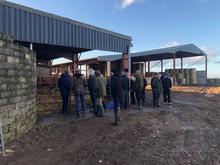Demonstration in Northern Europe

Demonstration in Northern Europe
One of my first tasks on joining the PLAID team was to synthesise the findings of eleven country reports from across Northern Europe, which were based on observations by PLAID and AgriDemo consortium members and subcontractors during the initial process of enrolling farmers and organisations into the demonstration inventory database. Together with findings from a Northern ‘supra-regional’ workshop held in Leuven in March 2018 (attended by consortium members, sub-contractors, representatives from the PLAID International Advisory Board and National Stakeholder Consultative Groups), these reports presented me with an interesting picture of the history and practice of on-farm demonstration from Scandinavia in the north, the British Isles in the west, Germany to the east, and France to the south. What a great introduction to the project!
History of demonstration farming in the region
The reports gave some fascinating insights into the evolution of demonstration, dating back at least 250 years to pioneering work by Hans Jakob Gujer (known as the ‘Philosophical Farmer’) who held meetings and discussion groups to demonstrate successful methods on his model farm in Zurich. The influence of this farmer was significant and far-reaching on agricultural spheres across the region and reportedly caused a stir throughout Europe. In other countries, the roots of demonstration also be traced back at least to the 19th Century – model farms began to be established across Europe, professional exchange became established through agricultural organisations, farmers could attend open days and demonstrations at agricultural fairs, and agricultural colleges began to bridge the gap between farmers and growing scientific knowledge on agricultural issues. Interestingly, reports from Scandinavia suggested that demonstration began to emerge a little later, where demonstration was more tightly bound with teaching.
Across Northern Europe, modern understanding and practice of demonstration evolved throughout the 20th Century. Differences in terms of actors, implementation and focus were evident, but all represent development of networks and structures to support exchange between farmers and other industry stakeholders.
Common topics and purposes of demonstration
Today, the most common reason to hold an on-farm demonstration in Northern Europe is to improve some aspect of agricultural production, including crop and livestock-related topics, how to improve efficiencies, machinery, and technology-focused topics. Soil fertility was also particularly high on the agenda. Environmental topics appear to be a relatively common focus of demonstration events in some countries, including measures relating to climate change, biodiversity, and nature management. In the context of explicitly sustainability-related demonstrations, greater emphasis appears to be on environmental sustainability over economic or social aspects – however, the economic benefits of environmental actions are usually still identified. Topics with an explicitly social focus (e.g. farm succession) didn’t appear to be a common focus, but social impacts were acknowledged in relation to the networking opportunity that demonstration events present.
Who are the ‘major’ providers and organisers?
A wide range of actors are involved in demonstration across the Northern European region. An important pattern seen across the region appears to be a partnership between agricultural extension and advisory services and individual farmers acting as demonstration hosts. Discussions in Leuven extended this suggestion, that demonstration provision across the region generally reflects the type of ‘AKIS’ (Agricultural Knowledge and Innovation Systems) arrangements in each country. In many cases, public and private sector organisations seem to work together with farmers to demonstrate.
Age and gender
Overall, farm demonstrations in the region are dominated by male participants, which was suggested to represent gender balance in the industry more generally. The only country that reports relatively even gender distribution overall is Norway. In France and Germany women appear to be represented in greater numbers about half of the time. In some cases, topic appears to have an impact on attendance – for example, beef was believed to attract more men and organic events, more women. Succession effects are slowing influencing gender balance over time, but childcare-related issues also place a persistent barrier to attendance in some contexts. Little or no information was available relating to participants’ positions in farming businesses.
In terms of age, there is a mix of representation across the region, however there is a general inclination towards the older age ranges, over 40-years old. Norway and Wales are the exceptions to this, where younger generations appear to be more dominant. It is also interesting to note that in some countries many attendees older than 40 are still described as ‘young’, as in ‘younger-than-average’ in relation to the farming population as a whole. It was agreed at the supra-regional meeting that demonstration events are attended by a younger demographic than there is in practice.
Regional differences
Demonstrations appear to be less common in areas that are more remote or have issues relating to access (e.g. islands), whereas there are more options available in more central areas – including cross-border visits. Concentration of events tends to reflect concentration of agricultural activity and more-specialist producers appear more likely to travel further to attend events. Interestingly, livestock events tend to be fewer – which was seen to reflect the relative number of other opportunities (e.g. markets and shows) for learning and interaction available.
There are some differences between countries in the region, and regional variations within country boundaries, which seem to reflect agriculture type and population distribution. The location of key organisation, institutions and extension services also appear to have had a significant influence. Other contributing factors discussed in Leuven include: the historical context of farming in different countries and regions; the number, power and credibility of farming organisations, advisors and researchers; levels and sources of funding available; the means of demonstration; and geography and logistics.
There are a wide range of on-farm demonstrations occurring across the Northern European supra-region, which bring together a range of industry stakeholders in the context of collaborative relationships and opportunities for interaction and exchange on a range of topics. Though context is important, founding principles and practices appear to be relatively consistent across the region.



